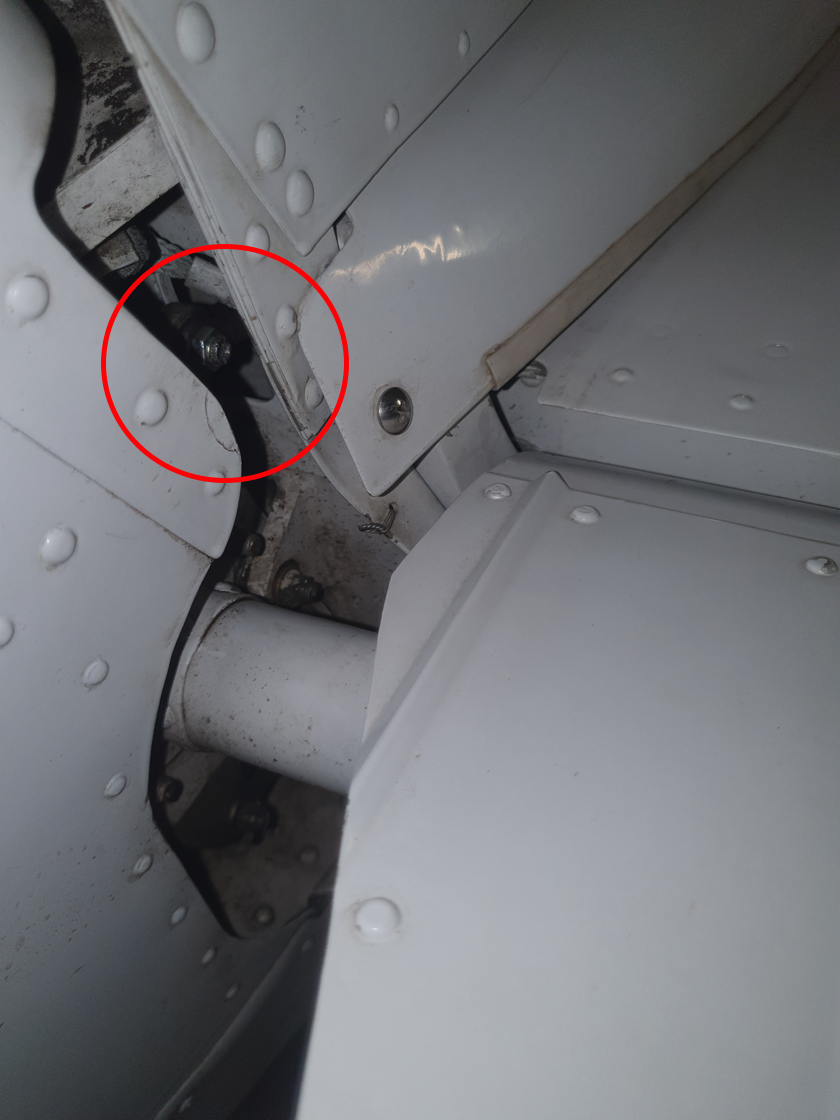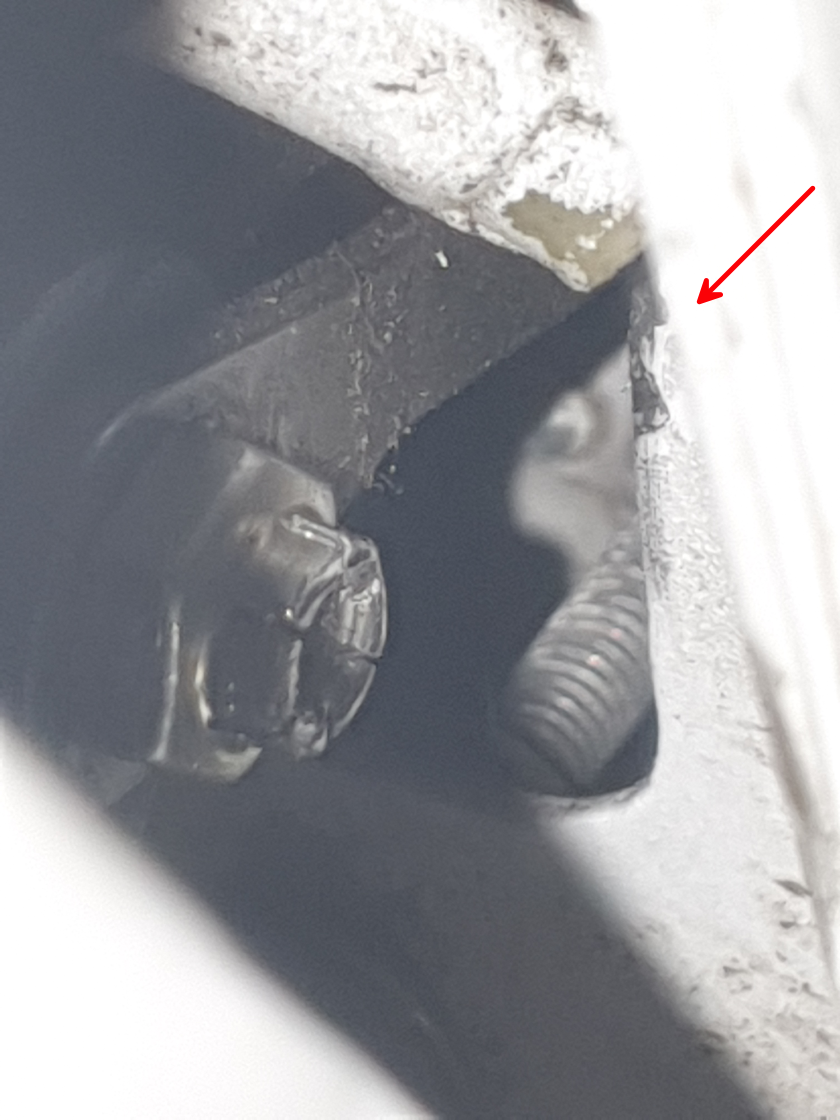One of my club’s Cessna 172’s the other day had its elevator stick in the full nose-up position during a “controls free” check on the ground.
It turned out that the screw fastening the elevator control wire to the elevator assembly had been installed the wrong way. The wire passes through an opening in a metal plate in the tail of the aircraft. The screw also moves through the opening when the elevator is near the full nose-up position, but not by much. The opening is not symmetric around the wire – it is narrower on the side of the screw head and wider on the other side where the nut is placed and the threads protrude a cm or so.
As the screw was installed the wrong way, the protruding part of it struck the plate at the side of the opening each time a controls full check was made. (This also slightly restricted full up elevator movement, but not enough to be noticeable.) Eventually the screw broke (metal fatigue, I guess) at the hole for the cotter pin. This allowed the screw to move slightly sideways and get stuck in the the opening, locking the elevator.
A screw doesn’t break just because it strikes metal a few times, so our guess is that the was installed incorrectly at the factory. The nut was also noticeable worn. We don’t know of any accident or inspection that would have necessitated removing the screw. (The aircraft is 16 years old and has some 4000 flight hours.)
It is scary to think of what would could have happened if the elevator stuck during a stall exercise.
This sounds like AD material as the same mistake could have been made when other aircraft were assembled. We’ll see what our maintenance shop says.
As a 172 owner this is of interest – thank you for posting.
Is this hole visible from the exterior of the aircraft directly or via an access panel? If so, which way should the screw be installed – head port or starboard?
Winston wrote:
Is this hole visible from the exterior of the aircraft directly or via an access panel? If so, which way should the screw be installed – head port or starboard?
It’s very visible and indeed the screw is one of the things I check at the preflight. But I never gave any though to the direction it was installed…
It should be installed head starboard. See this excerpt from the Cessna 172 parts catalog. The screw in question is item #15.

These pictures are taken from the starboard side of the fin facing forward. The screw is still mounted incorrectly but has a new nut to permit a ferry flight to the airport where we do our maintenance. You can see how the paint has been scraped off the side of the opening where the screw hit.


Thanks for the info. As a C172 renter I must admit I wouldn’t have noticed anything wrong with the screw during preflight if I go by the posted photo.
Airborne_Again wrote:
so our guess is that the was installed incorrectly at the factory
Well I don’t know any details, but maybe one doesn’t have to go so far back. If it has 4000 hours, for sure at one point in time the rudder had to be dismounted for any check to be performed and the screw was mounted by a technician in the wrong way.
Yet another reason to really do the control check.
While renting a nice 172SP in the states recently, as part of the walkaround on the checkout flight with an instructor I checked that the pushrods to the flaps were in good order.
Sure enough, one had been tightened such that the two rose joints on each end of the pushrod were not perpendicular, and one of them had loosened. The instructor remarked that in his thousands of hours of 172 time he’d never noticed that – I think he’d probably never checked :)
It’s a good idea to check all control linkages on a preflight, this is rarely taught IME but those who have been involved in maintenance tend to be more cautious.
Airborne_Again wrote:
This sounds like AD material as the same mistake could have been made when other aircraft were assembled. We’ll see what our maintenance shop says.
UdoR wrote:
Yet another reason to really do the control check.
Right, but the scary thing is that this wasn’t noticeable when you did the control check. I must have flown this aircraft hundreds of hours and never noticed anything odd at preflight or at the control check (or, indeed, in the air). I you actually lifted the elevator to the limit during preflight and looked carefully you would have noticed that the elevator bellcrank didn’t quite reach the stop screw but how many people do a preflight in that kind of detail?
There is more to this than meets the eye, in 4000 hours of flying this bolt should have been removed during maintenance so I very much doubt it is an issue from the factory.
I very much hope the aircraft was not flown with the nut fitted as in the photos, as the bolt has not entered the locking part of the nut.
If this aircraft was sitting in my hangar we would be looking into why the bolt was able to contact the structure, there is a reason for this and it needs to be fully investigated but checking the correct bolt ( part 15 ) and the condition of the bearing that bolt 18 passes through would be top of my list as would the path the cable takes to the first pulley forward of the bolt. However investigation might well go a lot further than this.
This is no trivial matter as there is something fundamentally wrong with the system and it is only down to good fortune that the aircraft was not lost.
A_and_C wrote:
I very much hope the aircraft was not flown with the nut fitted as in the photos, as the bolt has not entered the locking part of the nut.
The aircraft was approved by our CAO for a single ferry flight to a maintenance facility with the nut fitted as shown.
If this aircraft was sitting in my hangar we would be looking into why the bolt was able to contact the structure, there is a reason for this and it needs to be fully investigated but checking the correct bolt ( part 15 ) and the condition of the bearing that bolt 18 passes through would be top of my list as would the path the cable takes to the first pulley forward of the bolt. However investigation might well go a lot further than this.
I’m not sure I follow your reasoning. The fact that the opening in the plate was asymmetric shows that the design intended that the bolt should pass through the opening. How does the cables and pulley affect this?
This is no trivial matter as there is something fundamentally wrong with the system and it is only down to good fortune that the aircraft was not lost.
I agree it was not trivial as the elevator got stuck. But you mean there is (could be) something else wrong apart from the direction the bolt was inserted?